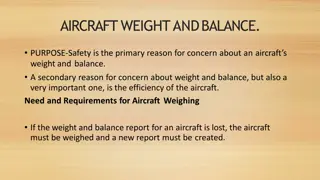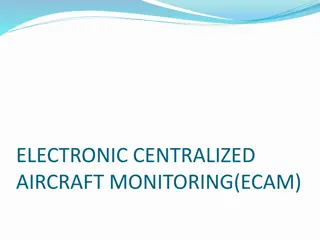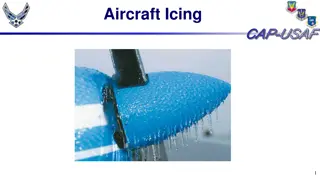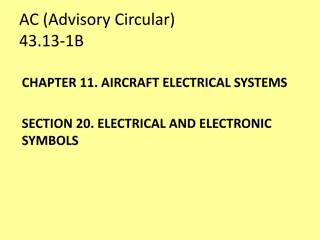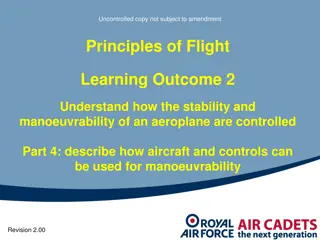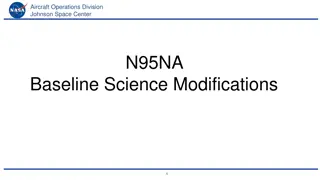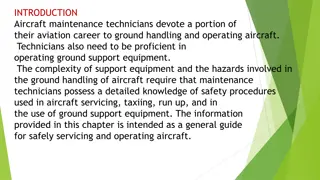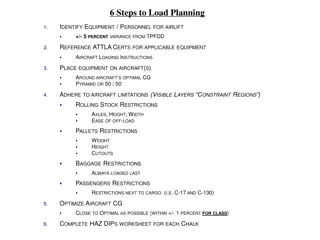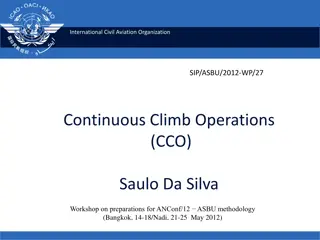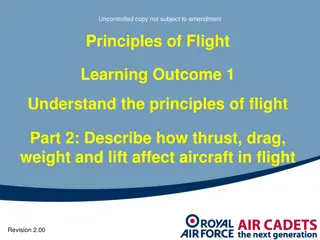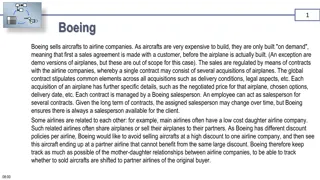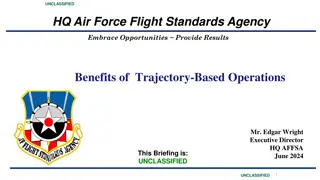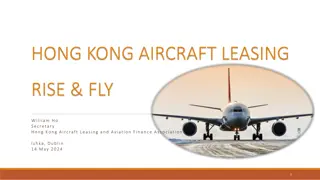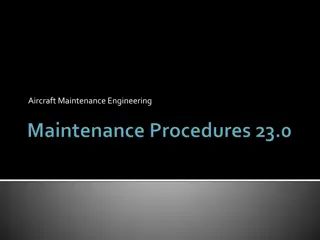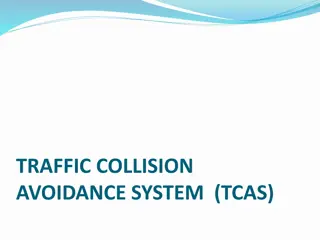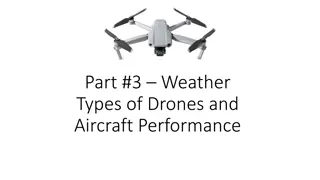Understanding Aircraft Stability and Manoeuvrability
Exploring the principles of flight, this content covers how the stability of an airplane is maintained, the forces involved in aircraft motion, and stability objectives related to different axes of rotation and planes of movement. It also delves into the effects of dihedral and anhedral on stability.
Download Presentation

Please find below an Image/Link to download the presentation.
The content on the website is provided AS IS for your information and personal use only. It may not be sold, licensed, or shared on other websites without obtaining consent from the author. Download presentation by click this link. If you encounter any issues during the download, it is possible that the publisher has removed the file from their server.
E N D
Presentation Transcript
Uncontrolled copy not subject to amendment Principles of Flight Learning Outcome 2 Understand how the stability and manoeuvrability of an aeroplane are controlled Part 1: Explain how the stability of an aeroplane is maintained Revision 2.00
Principles of Flight H Copter A Bourne C Tower B Loons A Ship R Way Dan Winterland S Huttle I Flyum Revision
1. What is the force called that drives an aircraft forwards? a. Lift b. Weight c. Drag d. Thrust
2. What is the force called that resists the forward motion of an aircraft? a. Lift b. Weight c. Drag d. Thrust
3. If your speed is doubled, by how much would drag be increased? a. x2 b. x4 c. x6 d. x8
4. If Thrust = Drag and Lift = Weight, then the aircraft is: a. Climbing b. Flying straight and level and accelerating c. Flying straight and level and decelerating d. Flying straight and level at constant speed
Stability Objectives: 1. Identify the axes of rotation for an aircraft 2. Identify the planes of movement for an aircraft 3. Describe and explain stability in the three planes of movement 4. Explain dihedral and anhedral and how they affect stability
Planes of stabilisation Longitudinal Axis Yaw Pitch (Directional) (Longitudinal) Roll (Lateral) Lateral Axis Normal Axis
Stabilisation Axis Plane Stability Longitudinal Rolling Lateral
To create roll, the control column is moved right
Left aileron down Right aileron up
The aircraft rolls right about the longitudinal axis
The aircraft rolls right and continues to do so until the control column is placed in the neutral position
Stabilisation Axis Plane Stability Longitudinal Rolling Lateral Lateral Pitching Longitudinal
To create pitch, the control column is pushed forwards
The elevator moves down
The aircraft pitches down about the lateral axis
The aircraft pitches down and continues to do so until the control column is placed in the neutral position The airspeed will increase
Stabilisation Axis Plane Stability Longitudinal Rolling Lateral Lateral Pitching Longitudinal Normal Yawing Directional
To create yaw, the one rudder pedal is moved forwards In this example, the right pedal is pushed forwards (the left will move backwards) The rudder moves to the right
The aircraft yaws to the right about the normal axis
The aircraft yaws to the right and continues to do so until the rudder pedals are set back to the neutral position
Stabilising Influence of the fin: 1. Value of lift 2. Moment arm CG Lift Flight path Enhancement features: Something causes the aircraft to yaw A large fin and/or a long moment arm
CG considerations An aft CG requires a large fin
Lift Flight path Weight To explain this stability, we assume that the CP and CG are coincident
Lift Lift Flight path Weight Something causes the nose to rise Lift wings - destabilising Lift tailplane - stabilising Area x Moment Arm = Tail Volume Stabilising influence of tailplane:
Lift Resultant sideslip Weight
Heading The aircraft sideslips in this direction All design features for lateral stability rely on the fact that bank results in sideslip
Lateral stability methods 1. Large fin of high aspect ratio (a big tall fin) Lift from fin rolls the wings level
2. Dihedral Due to new direction of relative airflow the lower wing has higher AoA than the upper This gives more lift and tends to roll wings level Lift
Lateral stability methods 2. Dihedral 1. High fin 3. Sweepback 4. High mounted wing Too much lateral stability (high wing and sweepback) is very undesirable in fighter aircraft Wings are therefore anhedral to reduce the excess lateral stability
1. What are the three planes of an aircrafts movement? a. Pitching, lateral and rolling b. Pitching, rolling and yawing c. Yawing, longitudinal and rolling d. Longitudinal, lateral and normal
2. Which one of the following will REDUCE lateral stability? a. Dihedral b. A large fin c. Sweepback d. Anhedral
3. What are the three axes about which an aircraft can move? a. Pitching, lateral and longitudinal b. Pitching, rolling and yawing c. Yawing, longitudinal and normal d. Longitudinal, lateral and normal
4. Which three terms describe static stability? a. Stable, neutral and unstable b. Stable, rolling and unstable c. Yawing, neutral and stable d. Neutral, unstable and pitching


